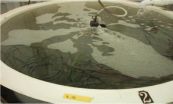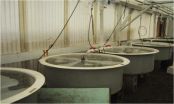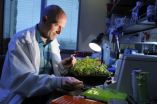(Press-News.org) SAN FRANCISCO -- A pearl net filled with seedpods, tethered by a rope anchored in the coastal mud but swaying with the tide, could be an especially effective way to restore disappearing marine meadows of eelgrass, according to a new study.
The resulting crop of eelgrass grown by SF State researchers is as genetically diverse as the natural eelgrass beds from which the seeds were harvested, said Sarah Cohen, an associate professor of biology at the Romberg Tiburon Center. As eelgrass meadows are threatened by a number of human activities, restoration plans that maintain diversity are more likely to succeed, she noted.
The emphasis on genetic diversity is a relatively new concern in ecosystem restoration projects, where there has been an understandable urgency to move plants and animals back into an area as quickly as possible. "It's taken a little longer for people to say, 'we need to know who we're moving,'" Cohen said, "and to explore how successful different genotypes are in different settings, so we can more strategically design the movement of individuals for restoration."
Eelgrass restoration projects are challenging because it's not easy to plant seedlings under the water, and seeds scattered over a large area could be washed away from the restoration site. Instead, RTC researchers tested the Buoy Deployed Seeding (BuDS) restoration technique. They first harvested eelgrass seedpods from several eelgrass beds in San Francisco Bay, then suspended the pods within floating nets over experimental tanks (called mesocosms) supplied with Bay water and with or without sediment from the original eelgrass areas. As the seeds inside each pod ripened, a few at a time, they dropped out of the nets and began to grow within the tanks.
The researchers then examined "genetic fingerprints" called microsatellites from the plants to measure the genetic diversity in each new crop. Genetic diversity can be measured in a number of ways, by looking at the number of different variants in a gene in a population, for instance, or by examining how these variants are mixed in an individual.
Based on these measurements and others, the new crops were nearly as genetically diverse as their parent grass beds, Cohen and colleagues found. "These offspring impressively maintained the genetic diversity and distinctiveness of their source beds in their new mesocosm environments at the RTC-SFSU lab," said Cohen.
"I think it's impressive how well it worked for a relatively small scale design," she added, "and that's one of the things we wanted to point out in the paper, since a lot of eelgrass restoration projects are so small, up to a few acres."
Sea grass meadows are a key marine environment under siege. In their healthy state, they stabilize coastal sediment and provide a huge nursery for a variety of algae, fish, shellfish and birds. But a variety of human influences, from bridge building to runoff pollution to smothering loads of sediment, have threatened these grass beds globally.
They're often overlooked and misunderstood, Cohen said. For instance, many of the eelgrass beds in the San Francisco Bay are submerged. "If you were out kayaking at low tide, you might see these grasses in places like Richardson Bay, which is full of a big meadow," she said.
During low tides, beachcombers could walk to eelgrass beds at places like Crown Beach in Alameda or Keller Beach in Richmond. But for the most part, "people might see the green blades washed up on the beach, and not realize that these are flowering plants instead of a piece of algae."
In classes at the RTC, students are learning how to combine genetics and ecology for projects that build better strategies to preserve the surprisingly distinct eelgrass meadows of San Francisco Bay. Cohen said that differences in water salinity, wind, sunlight, a sandy or silty bottom, and the kinds of organisms that live with the eelgrass all might play a role in creating such genetically different meadows.
INFORMATION:
"Conservation of Eelgrass (Zostera marina) Genetic Diversity in a Mesocosm-Based Restoration Experiment," by Cohen, Brian Ort, Katharyn Boyer, Laura Reynolds, Sheh May Tam and Sandy Wyllie Echeverria was published in the Feb. 21, 2014 issue of the journal PLOS ONE. It can be viewed online at http://dx.plos.org/10.1371/journal.pone.0089316.
SF State is the only master's-level public university serving the counties of San Francisco, San Mateo and Marin. The University enrolls nearly 30,000 students each year and offers nationally acclaimed programs in a range of fields -- from creative writing, cinema and biology to history, broadcast and electronic communication arts, theatre arts and ethnic studies. The University's more than 219,000 graduates have contributed to the economic, cultural and civic fabric of San Francisco and beyond.
Seed-filled buoys may help restore diverse sea meadows in San Francisco Bay
2014-02-22
ELSE PRESS RELEASES FROM THIS DATE:
Virginia Tech scientist proposes revolutionary naming system for all life on Earth
2014-02-22
A Virginia Tech researcher has developed a new way to classify and name organisms based on their genome sequence and in doing so created a universal language that scientists can use to communicate with unprecedented specificity about all life on Earth.
In a paper published in the journal PLoS ONE, Boris Vinatzer proposes moving beyond the current biological naming system to one based on the genetic sequence of each individual organism. This creates a more robust, precise, and informative name for any organism, be it a bacterium, fungus, plant, or animal.
Vinatzer, an ...
Antibody may be detectable in blood years before MS symptoms appear
2014-02-21
PHILADELPHIA – An antibody found in the blood of people with multiple sclerosis (MS) may be present long before the onset of the disease and its symptoms, according to a study released today that will be presented at the American Academy of Neurology's 66th Annual Meeting in Philadelphia, April 26 to May 3, 2014.
"If our results can be replicated in larger populations, our findings may help to detect MS earlier in a subgroup of patients," said study author Viola Biberacher, MD, with Technical University in Munich, Germany. "Finding the disease before symptoms appear ...
Selenium and vitamin E supplementation over recommended dietary intake may raise PC risk
2014-02-21
In a large clinical trial testing dietary supplements for prostate cancer (PCa) prevention, baseline selenium (Se) status (measured by toenail Se concentration), in the absence of supplementation, was not associated with prostate cancer (PCa) risk. However, when baseline toenail Se concentrations were high, supplementation with high-dose Se almost doubled the risk of high-grade PCa risk among older men, according to a new study published February 21 in the Journal of the National Cancer Institute.
High-dose vitamin E also more than doubled the risk high-grade PCa risk, ...
Selenium and vitamin E supplements can increase risk of prostate cancer in some men
2014-02-21
SEATTLE – A multi-center study led by Fred Hutchinson Cancer Research Center has found that high-dose supplementation with both the trace element selenium and vitamin E increase the risk of high-grade prostate cancer. But importantly, this risk depends upon a man's selenium status before taking the supplements.
These findings, published in Journal of the National Cancer Institute, are based on data from the Selenium and Vitamin E Cancer Prevention Trial, or SELECT, a rigorously executed, randomized and placebo-controlled trial conducted by the SWOG cancer research cooperative ...
Does a diet high in carbohydrates increase your risk of dementia?
2014-02-21
New Rochelle, NY, February 21, 2014—Even small increases in blood sugar caused by a diet high in carbohydrates can be detrimental to brain health. Recent reports in medical literature link carbohydrate calorie-rich diets to a greater risk for brain shrinkage, dementia and Alzheimer's disease, impaired cognition, and other disorders. David Perlmutter, MD, best-selling author of Grain Brain, explores this important topic in a provocative interview in Alternative and Complementary Therapies from Mary Ann Liebert, Inc., publishers. The article is available free on the Alternative ...
NASA's IRIS spots its largest solar flare
2014-02-21
VIDEO:
On Jan. 28, 2014, NASA's newly-launched Interface Region Imaging Spectrometer, or IRIS, observed its strongest solar flare to date.
Click here for more information.
On Jan. 28, 2014, NASA's Interface Region Imaging Spectrograph, or IRIS, witnessed its strongest solar flare since it launched in the summer of 2013. Solar flares are bursts of x-rays and light that stream out into space, but scientists don't yet know the fine details of what sets them off.
IRIS peers into ...
Is a 'buttery' molecule behind cystic fibrosis flare-ups?
2014-02-21
A molecule previously linked to lung injuries in factory workers producing microwave popcorn might play an important role in microbial infections of the lung suffered by people with cystic fibrosis (CF), according to a recent study led by San Diego State postdoctoral researcher Katrine Whiteson. The molecule, known as 2,3-butanedione or diacetyl, can be detected in higher concentrations in CF patients than in healthy ones.
CF patients experience day-to-day persistent coughing and increased mucus production, punctuated by periodic flare-ups of these symptoms, known as ...
New, inexpensive production materials boost promise of hydrogen fuel
2014-02-21
MADISON, Wis. — Generating electricity is not the only way to turn sunlight into energy we can use on demand. The sun can also drive reactions to create chemical fuels, such as hydrogen, that can in turn power cars, trucks and trains.
The trouble with solar fuel production is the cost of producing the sun-capturing semiconductors and the catalysts to generate fuel. The most efficient materials are far too expensive to produce fuel at a price that can compete with gasoline.
"In order to make commercially viable devices for solar fuel production, the material and the ...
Fruit-loving lemurs score higher on spatial memory tests
2014-02-21
DURHAM, N.C. -- Food-finding tests in five lemur species show that fruit-eaters may have better spatial memory than lemurs with a more varied diet.
The results support the idea that relying on foods that are seasonally available and far-flung gives a competitive edge to individuals with certain cognitive abilities -- such as remembering where the goodies are.
In a study appearing in the journal Animal Cognition, researchers Alexandra Rosati at Yale University and Kerri Rodriguez and Brian Hare of Duke compared spatial memory skills across five species of lemurs living ...
NASA sees Tropical Cyclone Guito exit the Mozambique Channel
2014-02-21
NASA's Terra satellite captured a visible image of Tropical Cyclone Guito as it exited the Mozambique Channel and moved into the open waters of the Southern Indian Ocean.
The Moderate Resolution Imaging Spectroradiometer or MODIS instrument that flies aboard NASA's Terra satellite captured a visible image of Tropical Cyclone Guito on Feb. 21 at 07:05 UTC/2:05 a.m. EST and took a visible image of the storm exiting the Mozambique Channel. The image showed bands of thunderstorms were still wrapping around the western quadrant of the storm.
At 0900 UTC/4 a.m. EST, Guito ...







